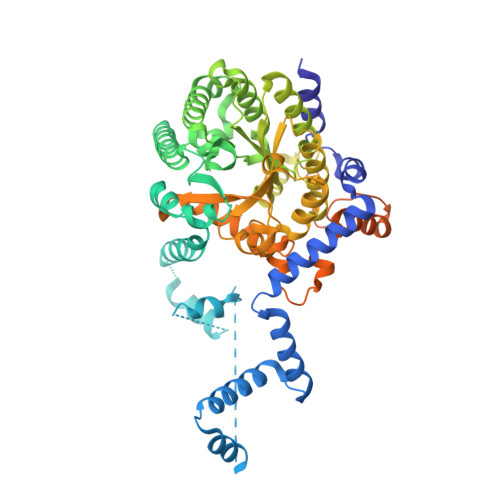Involvement of the beta 3-alpha 3 Loop of the Proline Dehydrogenase Domain in Allosteric Regulation of Membrane Association of Proline Utilization A.
Zhu, W., Haile, A.M., Singh, R.K., Larson, J.D., Smithen, D., Chan, J.Y., Tanner, J.J., Becker, D.F.(2013) Biochemistry 52: 4482-4491
- PubMed: 23713611
- DOI: https://doi.org/10.1021/bi400396g
- Primary Citation of Related Structures:
4JNY, 4JNZ - PubMed Abstract:
Proline utilization A (PutA) from Escherichia coli is a membrane-associated trifunctional flavoenzyme that catalyzes the oxidation of proline to glutamate and moonlights as a transcriptional regulator. As a regulatory protein, PutA represses transcription of the put regulon, which contains the genes encoding PutA and the proline transporter PutP. The binding of proline to the proline dehydrogenase active site and the subsequent reduction of the flavin induce high affinity membrane association of PutA and relieve repression of the put regulon, thereby causing PutA to switch from its regulatory to its enzymatic role. Here, we present evidence suggesting that residues of the β3-α3 loop of the proline dehydrogenase domain (βα)8 barrel are involved in proline-mediated allosteric regulation of PutA-membrane binding. Mutation of the conserved residues Asp370 and Glu372 in the β3-α3 loop abrogates the ability of proline to induce functional membrane association. Both in vitro lipid/membrane binding assays and in vivo cell-based assays demonstrate that mutagenesis of Asp370 (D370N/A) or Glu372 (E372A) dramatically impedes PutA functional switching. The crystal structures of the proline dehydrogenase domain mutants PutA86-630D370N and PutA86-630D370A complexed with the proline analogue l-tetrahydro-2-furoic acid show that the mutations cause only minor perturbations to the active site but no major structural changes, suggesting that the lack of proline response is not due to a failure of the mutated active sites to correctly bind the substrate. Rather, these results suggest that the β3-α3 loop may be involved in transmitting the status of the proline dehydrogenase active site and flavin redox state to the distal membrane association domain.
- Department of Biochemistry, Redox Biology Center, University of Nebraska-Lincoln, Lincoln, Nebraska 68588, USA.
Organizational Affiliation:



















